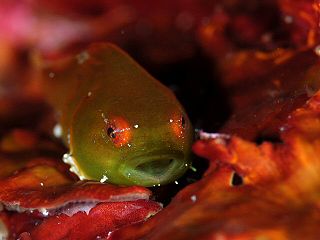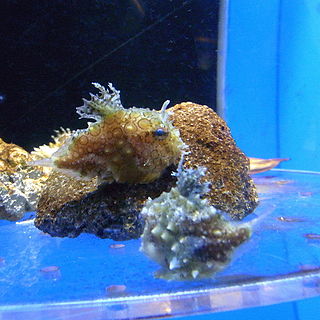
The Cyclopteridae are a family of marine fishes, commonly known as lumpsuckers or lumpfish, in the order Scorpaeniformes. They are found in the cold waters of the Arctic, North Atlantic, and North Pacific oceans. The greatest number of species are found in the North Pacific. The family name Cyclopteridae derives from the Greek words κύκλος (kyklos), meaning "circle", and πτέρυξ (pteryx), meaning "wing" or "fin", in reference to the circle-shaped pectoral fins of most of the fish in this family.

Cyclopterus lumpus, the lumpsucker or lumpfish, is a species of marine fish in the family Cyclopteridae (lumpsuckers). It is the only member of the genus Cyclopterus. It is found in the North Atlantic and adjacent parts of the Arctic Ocean, ranging as far south as Chesapeake Bay on the North American coast and Spain on the European coast.

Cleaner fish are fish that show a specialist feeding strategy by providing a service to other species, referred to as clients, by removing dead skin, ectoparasites, and infected tissue from the surface or gill chambers. This example of cleaning symbiosis represents mutualism and cooperation behaviour, an ecological interaction that benefits both parties involved. However, the cleaner fish may consume mucus or tissue, thus creating a form of parasitism called cheating. The client animals are typically fish of a different species, but can also be aquatic reptiles, mammals, or octopuses. A wide variety of fish including wrasse, cichlids, catfish, pipefish, lumpsuckers, and gobies display cleaning behaviors across the globe in fresh, brackish, and marine waters but specifically concentrated in the tropics due to high parasite density. Similar behaviour is found in other groups of animals, such as cleaner shrimps.

The smooth lumpfish is a species of lumpfish native to the North Pacific where it is found at depths down to 1,700 metres (5,600 ft). This species grows to a length of 41 centimetres (16 in) TL. It is the only known member of its genus.

Eumicrotremus is a genus of lumpfishes native to the northern oceans. The name for this genus comes from the Greek roots eu meaning "good", mikros meaning "small" or "little", and trema meaning "hole".

The Pacific spiny lumpsucker is a species of bony fish in the family Cyclopteridae.

Eumicrotremus asperrimus, also known as the Siberian lumpsucker, is a species of lumpfish native to the Northwest Pacific, where it can be found in the Bering Sea, the Sea of Japan, the Sea of Okhotsk, as well as off of Alaska and Hokkaido. It reaches 12 cm in total length and occurs at a depth range of 20 to 900 m. It is a round and compact fish adorned with many distinct tubercles.

Eumicrotremus spinosus, commonly known as the Atlantic spiny lumpsucker, is a species of lumpfish native to the Arctic and North Atlantic.

Eumicrotremus awae is a species of lumpfish endemic to the Pacific coast of Honshu, Japan, where it may be found from Chiba to Mie. It is a very small fish, reaching a maximum of 2 cm SL, and it occurs near shore at depths of less than 20 m. This species is variable in color, being typically seen as either vibrant green or red. It is known to feed on extremely small crabs, and was previously known as Lethotremus awae until it was reclassified in 2017 following a taxonomic review and the descriptions of two similar "dwarf" species in Eumicrotremus.

Eumicrotremus derjugini, also known as the leatherfin lumpsucker or petite poule de mer Arctique, is a species of lumpfish native to the Arctic, the North Atlantic, and the North Pacific. It is known from Labrador, Ungava Bay, Hudson Bay, the Canadian Arctic, Svalbard, the Barents Sea, Franz Josef Land, Greenland, the Kara Sea, the Laptev Sea, the East Siberian Sea, the Chukchi Sea, and the Sea of Okhotsk. It occurs at a depth range of 5 to 1038 m, and it reaches 10 cm SL. It is a benthic species often found on substrates of mud, gravel, or stone at temperatures below 0° C, feeding mainly on crustaceans and Oikopleura. The young of this species are reportedly seen in shallower water.
Eumicrotremus eggvinii, known as Eggvin's lumpsucker or the Eggvin lumpsucker, is a species of lumpfish known only from the Barents Sea. Until a 2016 revalidation, this species was considered to be synonymous with Eumicrotremus spinosus, though FishBase still lists E. eggvinii as a synonym of E. spinosus. This species can reportedly be distinguished from its relatives by the number and position of bone plaques.
Eumicrotremus jindoensis is a species of lumpfish native to the Northwest Pacific, where it may be found off the coast of the Korean Peninsula and in the Yellow Sea. It occurs at a depth range of 20 to 30 metres, and it reaches 2.5 centimetres (1 in) SL. This species was described in 2017 as part of a review of "dwarf" species of Eumicrotremus, which reclassified the species then known as Lethotremus awae as a member of Eumicrotremus in addition to describing another similarly small new species, known as Eumicrotremus uenoi.

Eumicrotremus pacificus, sometimes known as the spotted lumpsucker or the balloon lumpfish, is a species of lumpfish native to the Northwest Pacific. It can be found in the Sea of Okhotsk, the Sea of Japan, the East China Sea, and the Pacific Ocean off Hokkaido and the Kuril Islands. It may be confused with the closely related Eumicrotremus orbis, which overlaps with E. pacificus in range, although E. pacificus is larger, reaching 20 cm (7.9 inches) TL. This fish is generally yellow to orange in color with small dark spots and its tubercles are usually smaller and less pronounced than E. orbis, giving it a less spiny appearance.
Eumicrotremus schmidti is a species of lumpfish native to the Northwest Pacific. It is a demersal fish known only from the northern Sea of Okhotsk, where it is found at a depth range of 20 to 143 m. Specimens of E. schmidti were once attributed to the related species E. andriashevi, which does not inhabit the Sea of Okhotsk.

Eumicrotremus taranetzi is a species of lumpfish native to the Northwest Pacific. It is known from the Bering Sea, the Kuril Islands, the Sea of Okhotsk, and the Sea of Japan. It is a small demersal fish that reaches 5.9 cm SL.
Eumicrotremus tartaricus is a species of lumpfish native to the Northwest Pacific. It is known from the Sea of Japan, the Sea of Okhotsk, Peter the Great Bay, and the Pacific coast of the Kuril Islands, where it may be found at a depth range of 20 to 30 m.
Eumicrotremus terraenovae, also known as the Newfoundland spiny lumpsucker, is a species of lumpfish native to the Northwest Atlantic. It is a demersal fish found off of Newfoundland and in the Gulf of Maine.

Lethotremus muticus, also known as the docked snailfish, is a species of lumpfish native to the Northeast Pacific. It is known from the Bering Sea and the Aleutian Islands, where its range extends to Unimak Pass, and it occurs at a depth range of 58 to 330 m. It is a benthic species that reaches 11.5 Lethotremus, following a reclassification of the second described species in the genus as Eumicrotremus awae.
Microancathus fedorovi is a species of lumpfish native to the Northwest Pacific, where it is known from the northern Kuril Islands. It is a demersal fish that occurs at a depth range of 115 to 370 m. FishBase lists this species as a member of Eumicrotremus, contrary to a 2015 revision by O. S. Voskoboinikova that established the genus Microancathus, in addition to describing the species M. tokranovi.
Microancathus tokranovi is a species of lumpfish native to the Northwest Pacific, and one of two species in the genus Microancathus. It is known from the Kuril Islands. It is distinguished from its congener M. fedorovi by a taller body and flatter and less developed bone plaques. FishBase does not recognize this species or the genus Microancathus, placing M. fedorovi within Eumicrotremus. This species was described in 2015 alongside the establishment of Microancathus and the reclassification of M. fedorovi.











